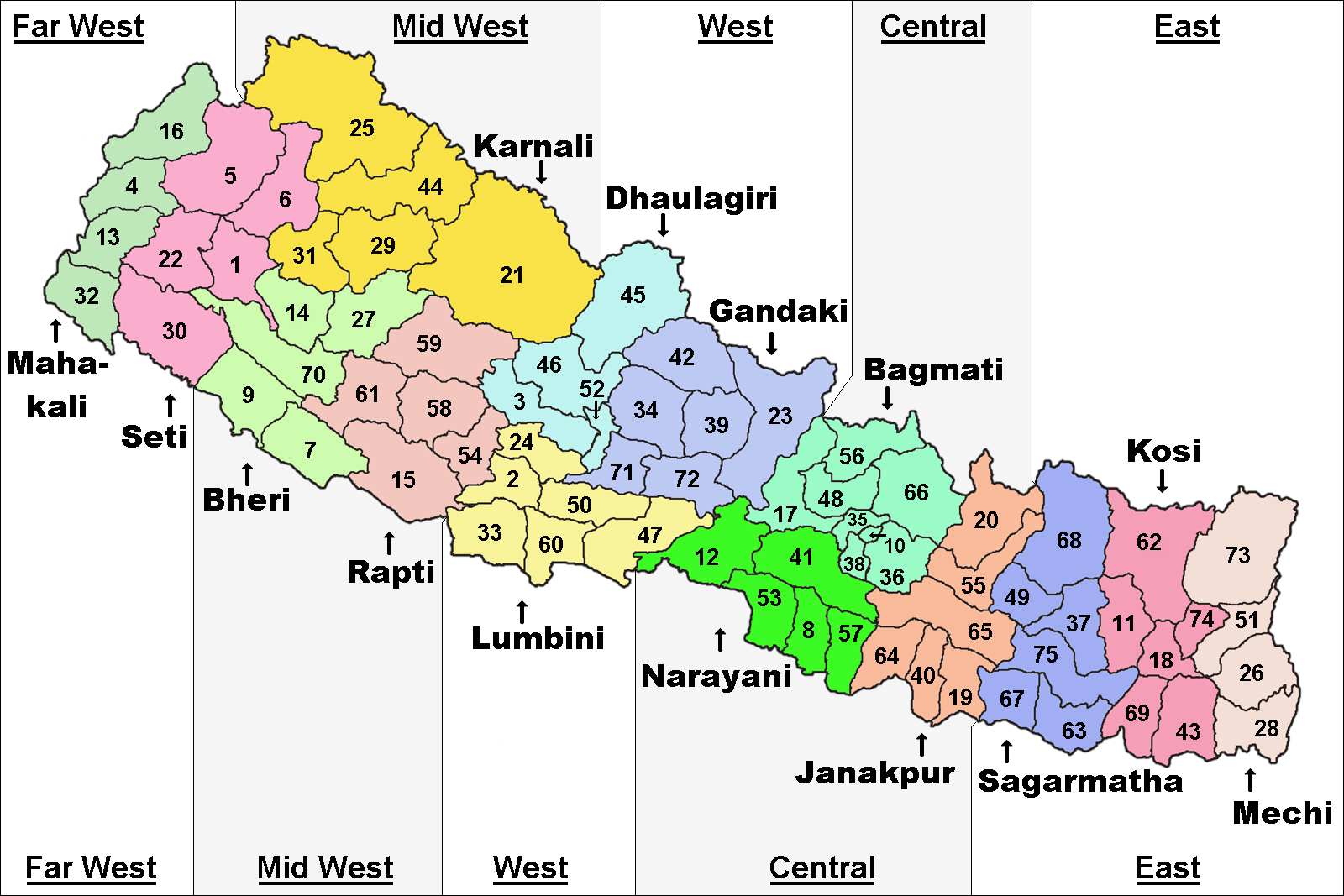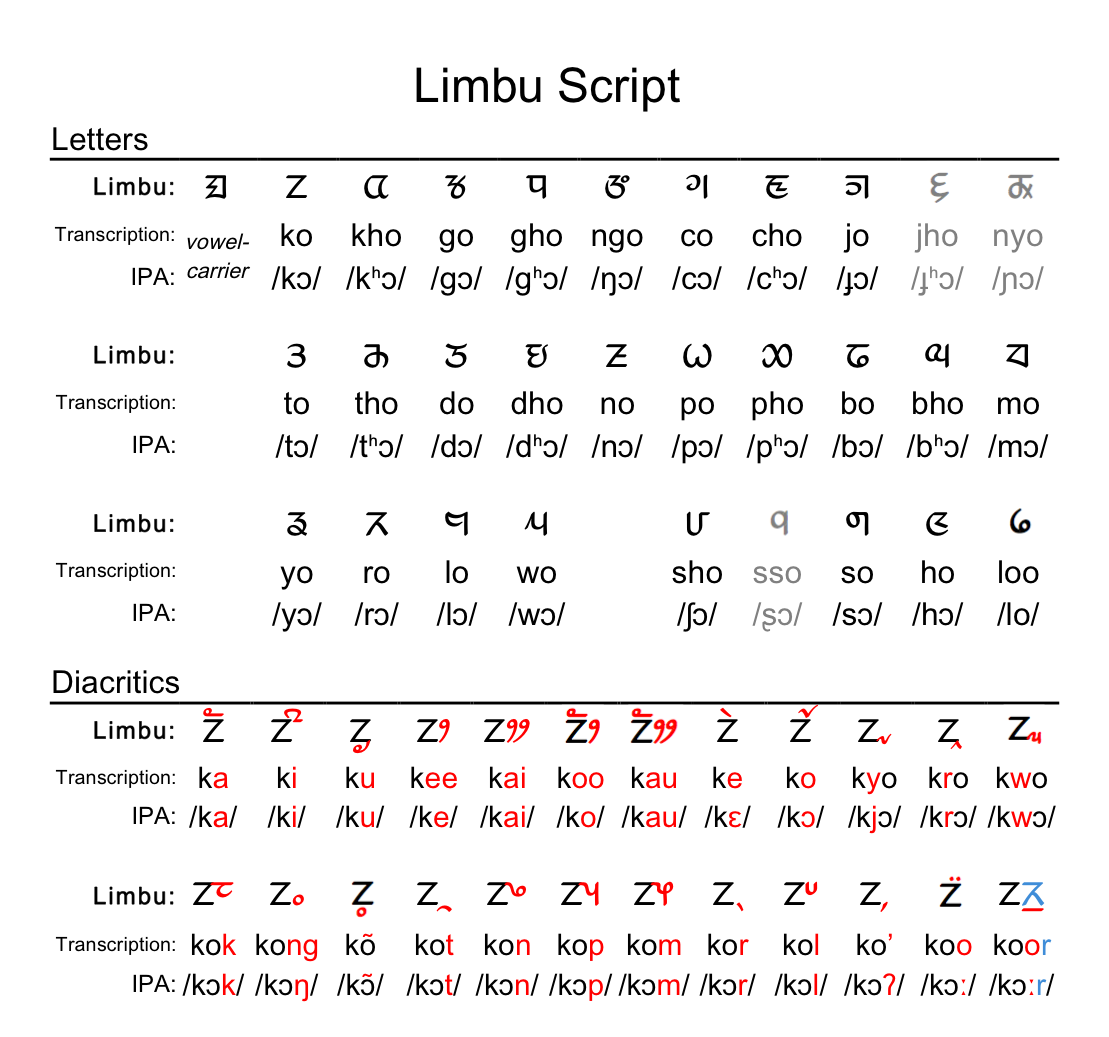|
Kiranti Languages
The Kiranti languages are a major family of Sino-Tibetan languages spoken in Nepal and India (notably Sikkim, Darjeeling, Kalimpong, and Bhutan) by the Kirati people. External relationships George van Driem had formerly proposed that the Kiranti languages were part of a Mahakiranti family, although specialists are not completely certain of either the existence of a Kiranti subgroup or its precise membership. LaPolla (2003), though, proposes that Kiranti may be part of a larger " Rung" group. Classification There are about two dozen Kiranti languages. Among the better known are Limbu, Sunuwar, Bantawa, Chamling, Khaling, Bahing, Yakkha, Wayu, Dungmali, Lohorung, and Kulung. Kiranti verbs are not easily segmentable, due in large part to the presence of portmanteau morphemes, crowded affix strings, and extensive (and often nonintuitive) allomorphy. Thus their relationship to each other has been a subject of debate. Overall, Kiranti languages are classified: ... [...More Info...] [...Related Items...] OR: [Wikipedia] [Google] [Baidu] |
Eastern Nepal
The Eastern Development Region ( Nepali: पुर्वाञ्चल विकास क्षेत्र, ''Purwānchal Bikās Kshetra'') was one of Nepal's five development regions. It is also known as Kirata region. It was located at the eastern end of the country with its headquarters at Dhankuta. The town of Dhankuta was the headquarter of the Eastern Region, as well as the headquarter of the Dhankuta District. History On April 13, 1961 Mahendra, the king of Nepal, divided the existing 35 districts into 75 districts and grouped them into 14 administrative zones. In 1972, the King of Nepal grouped 14 zones into total 4 development regions, thus Eastern Development Region came into existence. On 20 September 2015, Eastern Development Region including all other development regions of Nepal were abolished, when the new Constitution of Nepal-2015 was proclaimed. The total area of the region was 28,456 km². Administrative divisions The region administratively was d ... [...More Info...] [...Related Items...] OR: [Wikipedia] [Google] [Baidu] |
Limbu Language
Limbu (Limbu: , ''yakthuṅ pan'') is a Sino-Tibetan language spoken by the Limbu people of Nepal and Northeastern India (particularly West Bengal, Sikkim, Assam and Nagaland) as well as expatriate communities in Bhutan. The Limbu refer to themselves as ''Yakthung'' and their language as ''Yakthungpan.'' Yakthungpan has four main dialects: Phedape, Chhathare, Tambarkhole and Panthare dialects.A Grammar of Limbu By George van Driem 1987 Among four dialects, the Phedape dialect is widely spoken and well understood by most Yakthungpan speakers. However, as there are some dominant Panthare scholars who have role to create knowledge and control knowledge in the Limbu communities, Panthare dialect is being popularised as a "standard" Limbu language. As Panthare Yakthungs are much more engaged in central political position and administrative positions, they are trying to introduce Panthare dialect as a Standard Yakthungpan. Yakthungpan (Limbu language) is one of the major languages ... [...More Info...] [...Related Items...] OR: [Wikipedia] [Google] [Baidu] |
Affix
In linguistics, an affix is a morpheme that is attached to a word stem to form a new word or word form. The main two categories are Morphological derivation, derivational and inflectional affixes. Derivational affixes, such as ''un-'', ''-ation'', ''anti-'', ''pre-'' etc., introduce a semantic change to the word they are attached to. Inflectional affixes introduce a syntactic change, such as singular into plural (e.g. ''-(e)s''), or present simple grammatical tense, tense into present continuous or past tense by adding ''-ing'', ''-ed'' to an English word. All of them are bound morphemes by definition; prefixes and suffixes may be separable affixes. Affixes, infixes and their variations Changing a word by adding a morpheme at its beginning is called ''prefixation'', in the middle is called ''infixation'', and at the end is called ''suffixation''. ''Prefix'' and ''suffix'' may be subsumed under the term ''adfix'', in contrast to ''infix.'' When marking text for interlinear gl ... [...More Info...] [...Related Items...] OR: [Wikipedia] [Google] [Baidu] |
Morpheme
A morpheme is any of the smallest meaningful constituents within a linguistic expression and particularly within a word. Many words are themselves standalone morphemes, while other words contain multiple morphemes; in linguistic terminology, this is the distinction, respectively, between free and bound morphemes. The field of linguistic study dedicated to morphemes is called morphology. In English, inside a word with multiple morphemes, the main morpheme that gives the word its basic meaning is called a root (such as ''cat'' inside the word ''cats''), which can be bound or free. Meanwhile, additional bound morphemes, called affixes, may be added before or after the root, like the ''-s'' in ''cats'', which indicates plurality but is always bound to a root noun and is not regarded as a word on its own. However, in some languages, including English and Latin Latin ( or ) is a classical language belonging to the Italic languages, Italic branch of the Indo-European langua ... [...More Info...] [...Related Items...] OR: [Wikipedia] [Google] [Baidu] |
Portmanteau
In linguistics, a blend—also known as a blend word, lexical blend, or portmanteau—is a word formed by combining the meanings, and parts of the sounds, of two or more words together.Garner's Modern American Usage p. 644. English examples include '' smog'', coined by blending ''smoke'' and ''fog'', and '''', from ''motor'' ('' motorist'') and ''hotel''. A blend is similar to a [...More Info...] [...Related Items...] OR: [Wikipedia] [Google] [Baidu] |
Kulung Language (Nepal)
Kulung (autonym: ''Kulu riŋ'', ulu rɪŋ is one of the Kiranti languages. It is spoken by an estimated 33,000 people. Van Driem (2001) includes Chukwa as a dialect. Locations Kulung in some ten villages along the upper reaches of the Huṅga or Hoṅgu River (a tributary of the Dūdhkosī), in Solukhumbu District of Sagarmāthā Zone, Nepal. The main Kulung-speaking villages are Chhemsi and Chheskam. The particular dialect of the language spoken in these two villages is considered by the Kulung to be the most original form of their language. Downstream, on both sides of the Huṅga river, in villages that are now called Luchcham, Gudel, Chocholung, Nāmluṅg, Pilmo, Bung, Chhekmā, and Sātdi, less prestigious varieties of Kulung are spoken. ''Ethnologue'' lists the following Kulung villages: * Hongu River valley, Solukhumbu District, Sagarmatha Zone: Bung, Pelmang, Chhemsing, Chheskam, Lucham, Chachalung, Satdi, Gudel, Namlung, Sotang, and Chekma villages * Sankhuwasabh ... [...More Info...] [...Related Items...] OR: [Wikipedia] [Google] [Baidu] |
Lohorung Language
Lohorung, also spelled Lorung, Lohrung or Loharung, is a Kirati language of eastern Nepal. It has been described by George van Driem. Southern Lorung is also considered to be Southern Yamphu language. These varieties are all closely related. Geographical distribution Lohorung is spoken between the middle Arun valley and the Sabhakhola in central Sankhuwasabha District, Kosi Zone, in the villages of Pangma, Angala, Higuwa, Khorande, Bardeu, Gairiaula, Malta, Sitalpati, and Dhupu (''Ethnologue''). Southern Yamphu (Southern Lohorung) is spoken in Bodhe, Mounabudhuk, Bhedetar, and Rajaran villages in Dhankuta District, Kosi Zone (''Ethnologue ''Ethnologue: Languages of the World'' is an annual reference publication in print and online that provides statistics and other information on the living languages of the world. It is the world's most comprehensive catalogue of languages. It w ...''). It is also spoken in Devitar and Matsya Pokhari villages, northern Sankhuwa ... [...More Info...] [...Related Items...] OR: [Wikipedia] [Google] [Baidu] |
Dungmali Language
Dungmali, or Dungmali-Bantawa, is a Kiranti language spoken in Nepal. It is largely cognate with Bantawa language, but differs grammatically and phonologically. Locations Dungmali is spoken in eastern Bhojpur District, Koshi Province, in Thulo Dumba, Sano Dumba, and Bastim Similarly, Tiwari Bhanjyan, Chyangre, Yaku etc. which is also called Pouwakhesang Thum. VDC's (''Ethnologue ''Ethnologue: Languages of the World'' is an annual reference publication in print and online that provides statistics and other information on the living languages of the world. It is the world's most comprehensive catalogue of languages. It w ...''). The Dungmali area extends all the way east to the Arun River. In present days Dungmali's people are living in different countries Nepal, India, Bhutan, United States of America (USA). According to kirat Rai Dungmalis Bhasa Sanskriti Samrachhan Mancha, Dungmalis were generated from Hangwang, Pungwat, Pawen, Chokhang and Salukathewa Pachhas ‘ ... [...More Info...] [...Related Items...] OR: [Wikipedia] [Google] [Baidu] |
Wayu Language
Vayu (वायु), Wayu or Hayu (हायु) is a Sino-Tibetan language spoken in Nepal by about 1,520 people in Bagmati Province. Dialects include Pali gau (पालि गाउ) Mudajor Sukajor Ramechhap Sindhuli and Marin Khola. The Vayu language features SOV ordering. There are strong Nepali influences in its phonology, lexicon, and grammar. Its writing system uses the Devanagari script. There are no known monolingual speakers of the language, as its speaking population also uses Nepali. Despite a lack of monolingual children, use of Vayu has survived into the 21st century Frawley, W. (2003). Wayu. ''The International Encyclopedia of Linguistics.'' (Vol. 4, pp. 536) New York, NY: Oxford University Press, Inc. Phonology Grammar Geographical distribution Hayu is spoken in the following locations of Nepal. * Ramechhap District, Bagmati Province Bagmati Province (, ''Bāgmatī pradēśa'') is one of the seven Provinces of Nepal, provinces of Nepal ... [...More Info...] [...Related Items...] OR: [Wikipedia] [Google] [Baidu] |
Yakkha Language
Yakkha (also erroneously spelled as Yakha) is a language spoken in parts of Nepal, Darjeeling district and Sikkim. The Yakkha-speaking villages are located to the East of the Arun river, in the southern part of the Sankhuwasabha district and in the northern part of the Dhankuta district of Nepal. About 14,000 people still speak the language, out of 17,003 ethnic Yakkha in Nepal. Genealogically, Yakkha belongs to the Eastern Kiranti languages and is in one subgroup with several Limbu language, Limbu languages, e.g. Belhare language, Belhare, Athpare language, Athpare, Chintang language, Chintang and Chulung language, Chulung. Ethnically however, the Yakkha people perceive themselves as distinct from the other Kiranti groups such as Limbu people, Limbu. Geographical distribution Mugali is spoken between Mugakhola and Sinuwakhola on the eastern banks of the Arun River, China-Nepal, Arun River in Dhankuta District, Province No. 1, Nepal, in the villages (VDC's) of Muga, Nepal, Muga, ... [...More Info...] [...Related Items...] OR: [Wikipedia] [Google] [Baidu] |
Bahing Language
Bahing is one of the ethnicities present in Nepal which consist of the following ancestors: Paiwa, Dungmowa, Rukhusalu, Waripsawa, Timriwa, Dhimriwa, Nayango, Dhayango, Khaliwa/Khaluwa, Rendukpa/Rendu, and Rungbu. These ancestors spoke the Bahing language. The Bahing language was recorded (census 2021) to be spoken by 14449 people of the Bahing ethnic group in Nepal. It belongs to the family of Kiranti languages, a subgroup of Sino-Tibetan. The group Rumdali is also known as Nechali among some of them. Names ''Ethnologue'' lists the following alternate names for Bahing: Baying, Ikke lo, Kiranti-Bahing, Pai Lo, Radu lo. Procha lo Geographical distribution Bahing is spoken in the following locations of Nepal (''Ethnologue''). *Northeastern Okhaldhunga District, Sagarmatha Zone: Harkapur, Ragdip, Bigutar, Baruneswor, Okhaldhunga, Rumjatar, Barnalu, Mamkha, Ratmate, Serna, Diyale, and Bhadaure VDC's (''Rumdali dialect'') *Mid-southeastern Okhaldhunga District: Ketuke, ... [...More Info...] [...Related Items...] OR: [Wikipedia] [Google] [Baidu] |
Khaling Language
Khaling (kʰɛ̂l brâː ख्या:ल् ब्रा:) is a Kiranti language spoken in Solukhumbu district, Nepal and Sikkim, Darjeeling, and Kalimpong in India. It is one of the few Kiranti languages with tonal contrasts, which are of secondary origin. Khaling has approximately 15,000 speakers and is therefore considered a vulnerable language. Khaling has a complex system of stem alternations: as many as 10 distinct stems have to be posited for a word (Jacques et al. 2012). Khaling is very unusual in having an auditory demonstrative (see Jacques and Lahaussois 2014). Khaling is also known as Rai, Khalinge Rai, Khael Bra, and Khael Baat. General information Khaling is still being acquired by children who live in Khaling-speaking areas, as well as non-Khaling children who happen to live in that area. Geographical distribution Khaling is spoken in the following VDC's of Nepal (''Ethnologue''). *Solukhumbu District, Province No. 1: Kanku, Basa, Waku, Buksa, Jubing, Pa ... [...More Info...] [...Related Items...] OR: [Wikipedia] [Google] [Baidu] |


